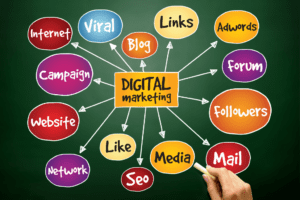Introduction
If you’re looking to learn more about the different definitions of digital marketing and branding, and the differences between the two, this post is for you. We’ll also discuss 9 key defining differences between marketing and branding, as well as how to blend the two techniques to create a successful brand. In addition, we’ll discuss the use of brand voice in your messaging, and how it can help you connect with your target audience. So whether you’re a beginner or an experienced marketer, read on for insights that will help you grow your business.
What is Digital Marketing?
Digital marketing is the practice of using digital technologies and channels to create, maintain, or improve customer relationships. It includes activities such as creating and delivering content, managing online engagement, setting up webpages and social media accounts, targeting customers with ads and other promotional campaigns, monitoring results regularly (and making necessary changes), and more.
There are several different ways that digital marketing can be used to reach your target audience. Some examples include developing targeted website content; producing engaging videos or blogs; designing effective email campaigns; developing powerful lead-generation forms; running paid search advertising on major search engines; building an active social media presence; etc.
The key to success with digital marketing is continual experimentation – trying out new strategies until you find ones that work best for your business goals and target audience. There’s no one right way to do it – just keep testing!
What is Branding?
Branding is the name, term, design, or concept associated with a product, service, or company. It can also refer to the process of creating this identity.
Many different types of branding exist today – from global brands like Coca-Cola and Apple to local businesses like Starbucks and Peet’s Coffee. Brands need to create an awareness of their products among consumers to stay competitive. They do this by developing a unique identity that sets them apart from their competitors. This identity is created through various marketing channels (such as advertising and communication), and it needs to be consistent across all platforms (web, mobile app, and social media).
Considering how important branding is today, it’s no wonder that so many businesses aim to get ahead of the competition by investing in branding initiatives early on in their development cycle. By doing so, they can establish themselves as leaders in their field and attract new customers along the way!
Digital Marketing vs Branding
Digital marketing and branding are two different but related fields. digital marketing is the process of creating, managing, executing, and measuring the results of marketing communications through the use of electronic technology. Branding is the strategic creation and distribution of a unique perceptual profile for a product or service offering that helps customers make an informed purchase decision.
So, what’s the difference?
Digital marketing focuses on delivering messages that are relevant to target audiences through various channels (such as online advertising, email newsletters, and social media platforms), while branding ensures that all customer interactions with a company reflect this unified brand identity. Both disciplines have their advantages and disadvantages – digital marketers can be more cost-effective because they don’t need upfront investments in tangible assets (like buildings or equipment) or personnel; meanwhile, branded companies may face higher costs associated with rebranding their businesses if they want to keep up with changes in consumer preferences. Ultimately, businesses need to choose an approach that works best for them based on their specific needs and marketing goals.
9 Important Marketing vs Branding Distinctions
1. Digital Marketing focuses on delivering messages through various channels (online advertising, email newsletters, social media platforms), while Branding ensures that all customer interactions reflect a unified brand identity.
2. Digital Marketing is the process of creating, managing, and executing marketing communications through electronic technology. Branding is the strategic creation and distribution of a unique perceptual profile for a product or service offering that helps customers make an informed purchase decision).
3. Digital Marketing can be more cost-effective because they don’t need upfront investments in tangible assets (like buildings or equipment) or personnel; meanwhile, Branding can cost more because it requires the expenditure of resources to create a unique perceptual profile.
4. Digital Marketing is focused on the creation, development, and execution of marketing plans that integrate various marketing channels like online advertising, email campaigns and social media efforts Branding focuses mainly on creating a distinctive image for a product or service – this might involve developing creative ideas such as logo design, slogans, and taglines.
5. Digital Marketing typically uses automated technologies while branding often employs people in creative roles who come up with original ideas or concepts to push the brand forward.
6. Digital Marketing relies on targeting specific demographics with ads and marketing messages Branding can take many different forms, but it is typically aimed at creating a favorable impression in the mind of consumers through effective communication strategies like positioning marketing communications, using persuasive media content and developing relationships with influential decision-makers).
7. Digital Marketing Tactics (like SEO) are used to improve visibility for a company’s online presence Branding efforts might also focus on improving recognition of unique product attributes that set it apart from its competitors (again through creative means such as branding and marketing messages).
8. Digital Marketing is typically goal-oriented while Branding can be more experiential, focused on creating a positive experience for customers in the present rather than projecting a future vision or goal.
9. Digital Marketing is often impatient with results while Branding can take longer to bear fruit but ultimately leads to more sustainable customer relationships and business growth.
How do you blend marketing and branding methods to create a cohesive strategy?
A well-crafted marketing and branding strategy should be based on the unique needs of your business or organization. To create a successful blend, you need to first understand your target market. What are their interests and values? How do they interact with other people and businesses? Once you have a good understanding of who you’re working with, it’s time to develop strategies that will appeal to them.
There are many different types of campaigns that can be used for this purpose, including advertising, public relations, website design and development, social media management, and more. You’ll need to decide which type(s) of marketing is best suited for your specific situation (price range allotted for advertising campaign; desired response from PR effort; etc.) Then craft an implementation plan that will ensure success.
The goal is always the same – to attract new customers while building long-term relationships with current ones. By taking these steps together, you can create a cohesive brand strategy that will help your business succeed in today’s competitive marketplace!
What is Brand Voice?
Brand voice is the tone, style, and language that a brand uses in its communication. It can be defined as “the collective self-image of a company or organization expressed through the words it chooses to use.”
Businesses need to develop a strong brand voice because it helps create trust and credibility with customers. In addition, effective branding allows businesses to target their marketing efforts more specifically. They can also better understand their audience and what appeals to them.
Four elements make up a Brand Voice: Tone, Style, Language, and Narrative.
Tone refers to how serious or humorous the brand is perceived to be. The tone of a business can vary from serious (e.g., IBM) to the fun (e.g., Starbucks).
Style refers to how formal or informal the brand appears its style may range from highly conservative (Ford Motor Company) to extremely casual (Nike).
Language refers to whether the language used by the company reflects its culture and values (words like ” bossy,” painful, “or “boring”) versus using neutral terms that everyone can understand (Toyota).
Narrative refers to the storyteller’s message that companies want to use oftentimes when selling products or services (e.g.,” We’re passionate about helping you live healthier lives”). Every business has its own unique story to hold onto the public on a community level. (Apple tells three different stories about rewired Macs, the Fitbit Charge 2 talks about tracking fitness and sleep, and Amazon tells the story of how they are transforming shopping).
Why is it Important to Use Brand Voice in your Messaging?
Brand voice is the unique way that a brand speaks to its audience. It’s the tone, personality, and style that a brand uses when communicating with customers or shareholders. When done well, it can create a sense of connection and understanding between the customers and the brand.
There are many reasons why it’s important to use brand voice in your messaging:
- It helps you connect with your audience on an emotional level. By speaking in a personal manner, you can tap into sentiments and feelings that resonate with them on an instinctive level. This makes it much easier for them to trust you (and spread the word about your product or service).
- It establishes credibility by demonstrating that you know what you’re talking about. When customers see that the company behind a product or message knows its stuff, they’re more likely to believe everything else they say about it too!
- The tone of your messages reflects the image of your company as a whole. If you want people to associate positive thoughts with your business, using a strong branding voice will help achieve this goal Implicitly.
So how do you develop an effective brand voice? There are no hard rules – each situation is different and requires individualized consideration. However, there are some key principles worth keeping in mind:
1) Be yourself – You should always be true to who you are as a businessperson and message sender
2) Speak from experience – Use examples from your own life or experiences to illustrate points
3) Use positive language – Be upbeat and encourage your audience to take action
4) Be clear, concise, and easy to understand – Brevity is key when trying to convey complex messages
5) Keep it simple – Oversimplification can lead people astray. Make sure everything you say is easily digestible, so they don’t have to stop and think too hard about what you’re saying After all, doesn’t our instinct sometimes prompt us to believe things simply because they sound good?
6) Use emotional hooks – Appeal to the emotions of your audience to create a sense of connection. This can be done by using words or visuals that evoke an emotional response
7) Be consistent – Make sure your message and appearance are always in line with each other so that customers can easily understand what’s expected of them.
8) Be adaptable – Positioning yourself as a leader in your field is one thing but staying ahead of the curve requires being willing to experiment and try new things. be open to feedback and learn from it
9) Remember: Branding isn’t about getting people to like you – it’s about getting them to do what you want.
Questions to ask when building a brand or marketing strategy
Building a brand or marketing strategy is not easy. It requires time, effort, and analysis of the current market conditions, as well as an understanding of your target audience. Once you have all of this information, it’s important to develop a plan that will help you reach your goals.
Several steps should be included in any successful branding or marketing strategy:
- Researching the competition – Are there any other brands in your industry that are doing well? What makes them unique? What do their customers love about them? By understanding what others are doing, you can start to build off of their success and create something entirely new.
- Defining who your target audience is – Who is most likely to buy what you’re selling? How old am I selling to? What gender am I targeting (men/women)? Once you have this information down pat, it’s easier to design content and advertising specifically for those demographics.
- Creating a sales funnel – This will allow you to track how many people come through each step of your customer journey (at home/on page/off page), which will give you valuable insights into where improvements need to be made.
When building a brand or marketing strategy, it’s important to ask yourself and your team some key questions.
- What is our mission? Why are we doing this? What do we want people to think of us when they hear our name or see our product/service?
- Who are our target customers/audiences? How can we best reach them?
- Where do we stand in the market today and where do we plan on positioning ourselves in the future?
- What resources (human, financial, etc.) will be necessary to achieve our goals?
- What type of content (text, image, video) should be produced to support the strategy and communicate with our audience?
- What do they want and need from me? What can I offer them that they cannot find elsewhere?
- Where will my products be sold (online, in retail stores, etc.)? And who will sell them to me (retailers, distributors, etc.)?
- Which channels will I use to communicate with my audience (social media platforms, email campaigns, ads/promotions on websites/apps)?
- How do you determine whether a particular marketing campaign is successful or not?
- What does your competition look like, and how can you compete with them?
Conclusion
The answer to all these questions is that branding and digital marketing go hand-in Bellevue. Digital marketing and branding are two areas that require smart strategies for good results, and the ones who can do that well will be in a better position to succeed.
But don’t be afraid of trial and error too – both methods have their pros and cons, so it’s important to figure out what works best for your brand before diving headfirst into a strategy. After all, being strategic can help you create powerful campaigns while also boosting brand awareness. You just need the right mix of experimentation and analysis!




Leave a Reply